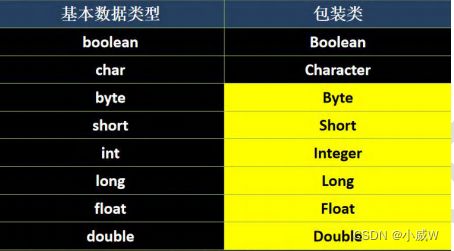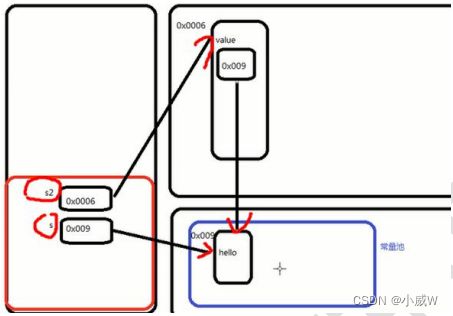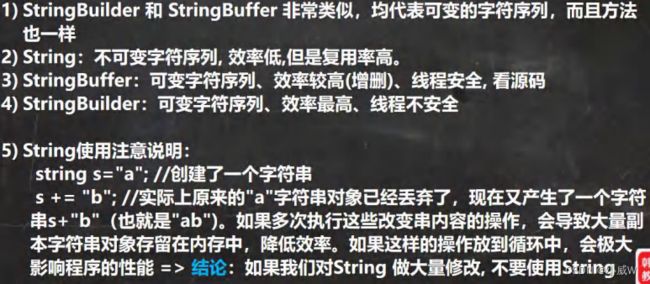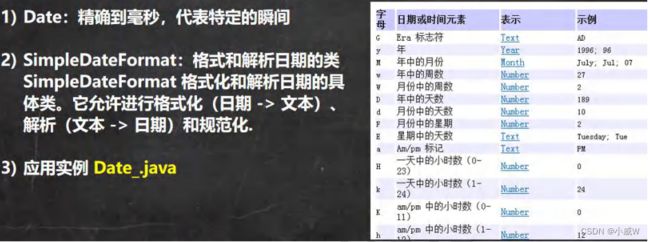13.常用类|Java学习笔记
文章目录
- 包装类
-
- 包装类型和String类型的相互转换
- Integer类和Character类的常用方法
- Integer创建机制&面试题
- String类
-
- 创建String对象的两种方式和区别
- 字符串的特性
- String类的常用方法
- StringBuffer类
-
- String和StringBuffer相互转换
- StringBuffer常用方法
- StringBuilder类
-
- String、StringBuffer 和 StringBuilder 的比较
- Math类
- Arrays类
- System类
- BigInteger和BigDeciaml类
- 日期类
-
- 第一代日期类
- 第二代日期类
- 第三代日期类
-
- 前两代日期类的不足分析
- DateTimeFormatter 格式日期类
- Instant 时间戳
包装类
针对八种基本数据类型相应的引用类型—包装类
java中int和integer之间的转换
jdk5之后可以直接:
int a = 1;
Integer b = a;
System.out.println(b);
int c = b;
System.out.println(c);
包装类型和String类型的相互转换
package com.fwedu.wrapper;
public class WrapperVsString {
public static void main(String[] args) {
// 方式一
Integer i = 100;
String str1 = i + "";
// 方式二
String str2 = i.toString();
// 方式三
String str3 = String.valueOf(i);
// String -> 包装类(Integer)
String str4 = "123456";
Integer i2 = Integer.parseInt(str4);
Integer i3 = new Integer(str4); // 已经是deprecated了
}
}
Integer类和Character类的常用方法
package com.fwedu.wrapper;
public class WrapperMethod {
public static void main(String[] args) {
System.out.println(Integer.MIN_VALUE); // int最小值
System.out.println(Integer.MAX_VALUE); // int最大值
System.out.println(Character.isDigit('a')); // 数字
System.out.println(Character.isLetter('a')); // 字母
System.out.println(Character.isUpperCase('a')); // 大写
System.out.println(Character.isLowerCase('a')); // 小写
System.out.println(Character.isWhitespace('a')); // 空格
System.out.println(Character.toUpperCase('a')); // 变成大写
System.out.println(Character.toLowerCase('a')); // 变成小写
}
}
Integer创建机制&面试题
package com.fwedu.wrapper;
public class WrapperExercise02 {
public static void main(String[] args) {
Integer i = new Integer(1);
Integer j = new Integer(1);
System.out.println(i == j); //False
//所以, 这里主要是看范围 -128 ~ 127 就是直接返回
/*
老韩解读
//1. 如果 i 在 IntegerCache.low(-128)~IntegerCache.high(127),就直接从数组返回
//2. 如果不在 -128~127,就直接 new Integer(i)
public static Integer valueOf(int i) {
if (i >= IntegerCache.low && i <= IntegerCache.high)
return IntegerCache.cache[i + (-IntegerCache.low)];
return new Integer(i);
}
*/
Integer m = 1; //底层 Integer.valueOf(1); -> 阅读源码
Integer n = 1;//底层 Integer.valueOf(1);
System.out.println(m == n); //True
//所以, 这里主要是看范围 -128 ~ 127 就是直接返回
//, 否则, 就 new Integer(xx);
Integer x = 128;//底层 Integer.valueOf(1);
Integer y = 128;//底层 Integer.valueOf(1);
System.out.println(x == y);//False
}
}
String类
- String对象用于保存字符串,也就是一组字符序列
- 字符串常量对象是用双引号括起的字符序列。例如: “你好”、“12.97”、 "boy"等
- 字符串的字符使用Unicode字符编码,一个字符(不区分字母还是汉字)占两个字节。
- String类较常用构造器(其它看手册,有很多):
String s1 = new String(); String s2 = new String(String original); String s3 = new String(char[] a); String s4 = new String(char[] a, int startIndex, int count)
- String 类实现了接口 Serializable【String 可以串行化:可以在网络传输】
接口 Comparable \【String 对象可以比较大小】 - String 是 final 类, 不能被其他的类继承
- String 有属性 private final char value[]; 用于存放字符串内容
- 一定要注意: value 是一个 final 类型, 不可以修改(需要功力): 即 value 不能指向新的地址, 但是单个字符内容是可以变化
创建String对象的两种方式和区别
方式一:直接赋值String s = “hsp”;
方式二:调用构造器String s2 = new String(“hsp”);
String s = "hsp";
String s2 = new String("hsp");
- 方式一:先从常量池查看是否有"hsp"数据空间,如果有,直接指向;如果没有则重新创建,然后指向。s最终指向的是常量池的空间地址。
- 方式二:先在堆中创建空间,里面维护了value属性,指向常量池的hsp空间。
如果常量池没有"hsp",重新创建,如果有,直接通过value指向。 s2最终指向的是堆中的空间地址。 - 画出两种方式的内存分布图如下:
package com.fwedu.string_;
public class StringExercise01 {
public static void main(String[] args) {
String a = "abc";
String b = "abc";
System.out.println(a.equals(b)); // t
System.out.println(a == b); // t
String c = new String("abc");
String d = new String("abc");
System.out.println(c.equals(d)); // t
System.out.println(c == d); // f
}
}
当调用 intern 方法时,如果池已经包含一个等于此 String 对象的字符串(用 equals(Object)方法确定),则返回池中的字符串。否则,将此 String 对象添加到池中,并返回此 String 对象的引用。
package com.fwedu.string_;
public class StringExercise03 {
public static void main(String[] args) {
// a指向常量池的"abc"
String a = "abc";
// b指向堆中对象
String b = new String("abc");
System.out.println(a.equals(b)); // t
System.out.println(a == b); // f
// b.intern()方法最终返回的时常量池的地址(对象)
System.out.println(a == b.intern()); // t
System.out.println(b == b.intern()); // f
// .intern()最终返回的是常量池的地址(对象)
System.out.println(a.intern()); // abc
System.out.println(b.intern()); // abc
}
}
字符串的特性
- String是一个final类,代表不可变的字符序列。
- 字符串是不可变的。一个字符串对象一旦被分配,其内容是不可变的。
String s1 = "hello";
s1 = "haha"; // 创建了两个对象
String a = "hello" + "abc"; // 创建了一个对象(编译器等价优化String a = "helloabc";)
String c1 = "ab" + "cd"; // 常量相加,看的是池
String c1 = a + b; // 变量相加,是在堆中
String类的常用方法
* equals //区分大小写,判断内容是否相等
* equalsIgnoreCase //忽略大小写的判断内容是否相等
* length //获取字符的个数,字符串的长度
* indexOf //获取字符在字符串中第1次出现的索引,索引从0开始,如果找不到,返回-1
* lastIndexOf //获取字符在字符串中最后1次出现的索引,索引从开始,如找不到,返回-1
* substring //截取指定范围的子串
* trim //去前后空格
* charAt //获取某索引处的字符,注意不能使用Str[index]这种方式
toUpperCase
toLowerCase
concat
s1 = s1.concat("abc").concat("def");
replace // 替换字符串中的字符
split // 分割字符串,返回值是String[]
String a = "jcck";
String b = "jackjk";
// 返回值是 'c' - 'a' = 2 的值
System.out.println(a.compareTo(b)); // 比较两个字符串的大小.前者大返回正数。如果前面的部分相同,就返回str1.len-str2.len
toCharArray // 转换成字符数组
format // 格式字符串 %s字符串 %c字符 %d整型 %.2f浮点型
String name = "john";
int age = 10;
String info = String.format("我的名字是%s 年龄是%d", name, age);
System.out.println(info); // 输出 我的名字是john 年龄是10
concat方法和+的区别
StringBuffer类
String类是保存字符串常量的。每次更新都需要重新开辟空间,效率较低,因此java设计者还提供了StringBuilder和 StringBuffer来增强String的功能,并提高效率。
String VS StringBuffer
- String 保存的是字符串常量,里面的值不能更改,每次String类的更新实际上就是更改地址, 效率较低 //private final char value[];
- StringBuffer保存的是字符串变量,里面的值可以更改,每次StringBuffer的更新实际上可以更新内容,不用每次更新地址,效率较高
//char[] value; //这个放在堆. 它的char[] value 不是final的
String和StringBuffer相互转换
package com.fwedu.stringbuffer_;
public class StringAndStringBuffer {
public static void main(String[] args) {
//看 String——>StringBuffer
String str = "hello tom";
//方式 1 使用构造器
//注意: 返回的才是 StringBuffer 对象, 对 str 本身没有影响
StringBuffer stringBuffer = new StringBuffer(str);
//方式 2 使用的是 append 方法
StringBuffer stringBuffer1 = new StringBuffer();
stringBuffer1 = stringBuffer1.append(str);
//看看 StringBuffer ->String
StringBuffer stringBuffer3 = new StringBuffer("韩顺平教育");
//方式 1 使用 StringBuffer 提供的 toString 方法
String s = stringBuffer3.toString();
//方式 2: 使用构造器来搞定
String s1 = new String(stringBuffer3);
}
}
StringBuffer常用方法
package com.fwedu.stringbuffer_;
public class StringBufferMethod {
public static void main(String[] args) {
StringBuffer s = new StringBuffer("hello");
//增
s.append(',');// "hello,"
s.append("张三丰");//"hello,张三丰"
s.append("赵敏").append(100).append(true).append(10.5);//"hello,张三丰赵敏 100true10.5"
System.out.println(s);//"hello,张三丰赵敏100true10.5"
//删
/*
* 删除索引为>=start &&
s.delete(11, 14);
System.out.println(s);//"hello,张三丰赵敏true10.5"
//改
//老韩解读, 使用 周芷若 替换 索引 9-11 的字符 [9,11)
s.replace(9, 11, "周芷若");
System.out.println(s);//"hello,张三丰周芷若true10.5"
//查找指定的子串在字符串第一次出现的索引, 如果找不到返回-1
int indexOf = s.indexOf("张三丰");
System.out.println(indexOf);//6
//插
//老韩解读, 在索引为 9 的位置插入 "赵敏",原来索引为 9 的内容自动后移
s.insert(9, "赵敏");
System.out.println(s);//"hello,张三丰赵敏周芷若 true10.5"
//长度
System.out.println(s.length());//22
System.out.println(s);
}
}
上面代码中出现的方法有:
s.append("赵敏").append(100).append(true).append(10.5); // 增
s.delete(11, 14); // 删除
s.replace(9, 11, "周芷若"); // 修改
s.indexOf("张三丰"); // 查找第一次出现的索引,找不到返回-1
s.insert(9, "赵敏"); // 插入
public class StringBufferExercise01 {
public static void main(String[] args) {
String str = null;
StringBuffer sb = new StringBuffer();
sb.append(str); // 底层调用的是AbstractStringBuilder的appendNull
System.out.println(sb.length());
System.out.println(sb);
// 会抛出空指针异常NullPointerException
StringBuffer stringBuffer = new StringBuffer(str);
System.out.println(stringBuffer);
}
}
上面的两个 sout 会输出:
4
null
即 str = null 被当成了 字符串"null" 加入到 sb 中了。
而StringBuffer stringBuffer = new StringBuffer(str);这一行会抛出空指针异常。
StringBuilder类
- 一个可变的字符序列。此类提供一个与StringBuffer兼容的API,但不保证同步(StringBuilder不是线程安全)。该类被设计用作StringBuffer的一个简易替换,用在字符串缓冲区被单个线程使用的时候。如果可能,建议优先采用该类因为在大多数实现中,它比StringBuffer要快。
- 在StringBuilder上的主要操作是append和insert方法,可重载这些方法,以接受任意类型的数据。
StringBuffer 多线程
StringBuilder 单线程
StringBuilder 的方法使用和 StringBuffer 基本一样。
String、StringBuffer 和 StringBuilder 的比较
使用的原则, 结论:
- 如果字符串存在大量的修改操作,一般使用StringBuffer或StringBuilder
- 如果字符串存在大量的修改操作,并在单线程的情况,使用StringBuilder
- 如果字符串存在大量的修改操作,并在多线程的情况,使用StringBufer
- 如果我们字符串很少修改,被多个对象引用,使用String,比如配置信息等
Math类
Math 类包含用于执行基本数学运算的方法,如初等指数、对数、平方根和三角函数。
https://www.apiref.com/java11-zh/java.base/java/lang/Math.html
均为静态方法。
// random 求随机数 返回带有正号的 double值,大于或等于 0.0且小于 1.0 。
// random 返回的是 0 <= x < 1 之间的一个随机小数 [0, 1)
// 思考: 请写出获取 a-b 之间的一个随机整数,a,b 均为整数 , 比如 a = 2, b=7
// 即返回一个数 x 2 <= x <= 7
// 解读 Math.random() * (b-a) 返回的就是 0 <= 数 <= b-a
// (1) (int)(a) <= x <= (int)(a + Math.random() * (b-a +1) )
// (2) 使用具体的数给小伙伴介绍 a = 2 b = 7
// (int)(a + Math.random() * (b-a +1) ) = (int)( 2 + Math.random()*6)
// Math.random()*6 返回的是 0 <= x < 6 小数
// 2 + Math.random()*6 返回的就是 2<= x < 8 小数
// (int)(2 + Math.random()*6) = 2 <= x <= 7
// (3) 公式就是 (int)(a + Math.random() * (b-a +1) )
Arrays类
Java 自定义排序
【Java】自定义排序
【java】数组相关知识点汇总
System类
package com.fwedu.system_;
import java.util.Arrays;
public class System_ {
public static void main(String[] args) {
int[] src = {1, 2, 3};
int[] dest = new int[3];
System.arraycopy(src, 0, dest, 1, 2);
System.out.println(Arrays.toString(dest));
System.out.println(System.currentTimeMillis());
System.out.println("ok1");
System.exit(0);
System.out.println("ok2");
}
}
输出结果为:
[0, 1, 2]
1686555181555
ok1
BigInteger和BigDeciaml类
Java【大数类】整理
日期类
第一代日期类
使用代码示例:
package com.fwedu.date_;
import java.text.ParseException;
import java.text.SimpleDateFormat;
import java.util.Date;
/**
* @author 冯威
*/
public class Date01 {
public static void main(String[] args) throws ParseException {
//老韩解读
//1. 获取当前系统时间
//2. 这里的 Date 类是在 java.util 包
//3. 默认输出的日期格式是国外的方式, 因此通常需要对格式进行转换
Date d1 = new Date(); //获取当前系统时间
System.out.println("当前日期=" + d1);
Date d2 = new Date(9234567); //通过指定毫秒数得到时间
System.out.println("d2=" + d2); //获取某个时间对应的毫秒数
//老韩解读
//1. 创建 SimpleDateFormat 对象, 可以指定相应的格式
//2. 这里的格式使用的字母是规定好, 不能乱写
SimpleDateFormat sdf = new SimpleDateFormat("yyyy 年 MM 月 dd 日 hh:mm:ss E");
String format = sdf.format(d1); // format:将日期转换成指定格式的字符串
System.out.println("当前日期=" + format);
//老韩解读
//1. 可以把一个格式化的 String 转成对应的 Date
//2. 得到 Date 仍然在输出时, 还是按照国外的形式, 如果希望指定格式输出, 需要转换
//3. 在把 String -> Date , 使用的 sdf 格式需要和你给的 String 的格式一样, 否则会抛出转换异常
String s = "1996 年 01 月 01 日 10:20:30 星期一";
Date parse = sdf.parse(s);
System.out.println("parse=" + parse);
System.out.println("parse=" + sdf.format(parse));
}
}
上面代码中出现的方法有:
Date d1 = new Date(); //获取当前系统时间
Date d2 = new Date(9234567); //通过指定毫秒数得到时间
SimpleDateFormat sdf = new SimpleDateFormat("yyyy 年 MM 月 dd 日 hh:mm:ss E");
String s = "1996 年 01 月 01 日 10:20:30 星期一";
Date parse = sdf.parse(s); // 解析
System.out.println("parse=" + parse);
System.out.println("parse=" + sdf.format(parse)); // 格式化
第二代日期类
第二代日期类,主要就是Calendar类(日历)。
public abstract class Calendar implements Serializable, Cloneable, Comparable<Calendar> {
}
Calendar类是一个抽象类,它为特定瞬间与一组诸如YEAR、MONTH、DAY_OF MONTH、HOUR等日历字段之间的转换提供了一些方法,并为操作日历字段(例如获得下星期的日期)提供了一些方法。
package com.fwedu.date_;
import java.util.Calendar;
public class Calendar01 {
public static void main(String[] args) {
//老韩解读
//1. Calendar 是一个抽象类, 并且构造器是 private
//2. 可以通过 getInstance() 来获取实例
//3. 提供大量的方法和字段提供给程序员
//4. Calendar 没有提供对应的格式化的类, 因此需要程序员自己组合来输出(灵活)
//5. 如果我们需要按照 24 小时进制来获取时间, Calendar.HOUR ==改成=> Calendar.HOUR_OF_DAY
Calendar c = Calendar.getInstance(); //创建日历类对象//比较简单, 自由 (因为是抽象类所以不能new)
System.out.println("c=" + c);
//2.获取日历对象的某个日历字段
System.out.println("年: " + c.get(Calendar.YEAR));
// 这里为什么要 + 1, 因为 Calendar 返回月时候, 是按照 0 开始编号
System.out.println("月: " + (c.get(Calendar.MONTH) + 1));
System.out.println("日: " + c.get(Calendar.DAY_OF_MONTH));
System.out.println("小时: " + c.get(Calendar.HOUR));
System.out.println("分钟: " + c.get(Calendar.MINUTE));
System.out.println("秒: " + c.get(Calendar.SECOND));
//Calender 没有专门的格式化方法, 所以需要程序员自己来组合显示
System.out.println(c.get(Calendar.YEAR) + "-" + (c.get(Calendar.MONTH) + 1) + "-" +
c.get(Calendar.DAY_OF_MONTH) +
" " + c.get(Calendar.HOUR_OF_DAY) + ":" + c.get(Calendar.MINUTE) + ":" + c.get(Calendar.SECOND) );
}
}
输出如下:
c=java.util.GregorianCalendar[time=1686564400356,areFieldsSet=true,areAllFieldsSet=true,lenient=true,zone=sun.util.calendar.ZoneInfo[id="Asia/Shanghai",offset=28800000,dstSavings=0,useDaylight=false,transitions=31,lastRule=null],firstDayOfWeek=1,minimalDaysInFirstWeek=1,ERA=1,YEAR=2023,MONTH=5,WEEK_OF_YEAR=24,WEEK_OF_MONTH=3,DAY_OF_MONTH=12,DAY_OF_YEAR=163,DAY_OF_WEEK=2,DAY_OF_WEEK_IN_MONTH=2,AM_PM=1,HOUR=6,HOUR_OF_DAY=18,MINUTE=6,SECOND=40,MILLISECOND=356,ZONE_OFFSET=28800000,DST_OFFSET=0]
年: 2023
月: 6
日: 12
小时: 6
分钟: 6
秒: 40
2023-6-12 18:6:40
第三代日期类
前两代日期类的不足分析
package com.fwedu.date_;
import java.time.LocalDate;
import java.time.LocalDateTime;
import java.time.LocalTime;
import java.time.format.DateTimeFormatter;
public class LocalDateTime01 {
public static void main(String[] args) {
//第三代日期
//老韩解读
//1. 使用 now() 返回表示当前日期时间的 对象
LocalDateTime ldt = LocalDateTime.now();
System.out.println(ldt);
//2. 使用 DateTimeFormatter 对象来进行格式化
// 创建 DateTimeFormatter 对象
DateTimeFormatter dateTimeFormatter = DateTimeFormatter.ofPattern("yyyy-MM-dd HH:mm:ss");
String format = dateTimeFormatter.format(ldt);
System.out.println("格式化的日期=" + format);
System.out.println("年=" + ldt.getYear());
System.out.println("月=" + ldt.getMonth());
System.out.println("月=" + ldt.getMonthValue());
System.out.println("日=" + ldt.getDayOfMonth());
System.out.println("时=" + ldt.getHour());
System.out.println("分=" + ldt.getMinute());
System.out.println("秒=" + ldt.getSecond());
//可以获取年月日
LocalDate now = LocalDate.now();
//获取到时分秒
LocalTime now2 = LocalTime.now();
//提供 plus 和 minus 方法可以对当前时间进行加或者减
//看看 890 天后, 是什么时候 把 年月日-时分秒
LocalDateTime localDateTime = ldt.plusDays(890);
System.out.println("890 天后=" + dateTimeFormatter.format(localDateTime));
//看看在 3456 分钟前是什么时候, 把 年月日-时分秒输出
LocalDateTime localDateTime2 = ldt.minusMinutes(3456);
System.out.println("3456 分钟前 日期=" + dateTimeFormatter.format(localDateTime2));
}
}
DateTimeFormatter 格式日期类
关于 DateTimeFormatter 的各个格式参数,需要看 jdk8 的文档。
import java.time.format.DateTimeFormatter;
DateTimeFormatter dateTimeFormatter = DateTimeFormatter.ofPattern("yyyy-MM-dd HH:mm:ss");
String format = dateTimeFormatter.format(ldt);
Instant 时间戳
package com.fwedu.date_;
import java.time.Instant;
import java.util.Date;
public class Instant01 {
public static void main(String[] args) {
//1.通过 静态方法 now() 获取表示当前时间戳的对象
Instant now = Instant.now();
System.out.println(now);
//2. 通过 from 可以把 Instant 转成 Date
Date date = Date.from(now);
//3. 通过 date 的 toInstant() 可以把 date 转成 Instant 对象
Instant instant = date.toInstant();
}
}







